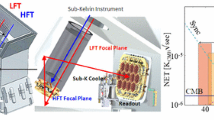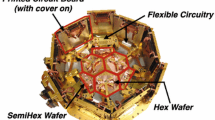Abstract
In 2012 the South Pole Telescope (SPT) will begin a 625 deg2 survey to measure the polarization anisotropy of the cosmic microwave background (CMB). Observations of the CMB B-mode angular power spectrum will be used to search for the large angular scale signal induced by inflationary gravitational waves. Additionally, the B-mode spectrum will enable a measurement of the neutrino mass through the gravitational lensing of the CMB. The new 780 pixel polarization-sensitive camera is composed of two different detector architectures and will map the sky at two frequencies. At 150 GHz, the camera consists of arrays of corrugated feedhorn-coupled TES polarimeters fabricated at the National Institute of Standards and Technology (NIST). At 90 GHz, we use individually packaged dual-polarization absorber-coupled polarimeters developed at Argonne National Laboratory. Each 90 GHz pixel couples to the telescope through machined contoured feedhorns. The entire focal plane is read out using a digital frequency-domain multiplexer system. We discuss the design and goals of this experiment and provide a description of the detectors.



Similar content being viewed by others
References
S. Dodelson et al., arXiv:0902.3796 (2009)
J. Lesgourgues, S. Pastor, Phys. Rep. 429, 307 (2006)
J. Kovac et al., Nature 420, 772 (2002)
C. Pryke et al., Astrophys. J. 692, 1247–1270 (2009)
C.H. Chiang et al., Astrophys. J. 711, 1123–1140 (2010)
QUIET Collaboration, arXiv:1012.3191 (2010)
J.E. Carlstrom et al., Publ. Astron. Soc. Pac. 123, 568 (2011)
K. Vanderlinde et al., Astrophys. J. 722, 1180 (2010)
R. Williamson et al., Astrophys. J. 738, 139 (2011). arXiv:1101.1290
R. Keisler et al., Astrophys. J. 743, 28 (2011). arXiv:1105.3182
E. Shirokoff et al., Astrophys. J (in press) (2011). arXiv:1012.4788
P.A. Ade, R. Pisano, G.C. Tucker, S. Weaver, Proc. SPIE 6275, 62750U (2006)
M. Dobbs et al., IEEE Trans. Nucl. Sci. 55(l), 21–26 (2008)
J. McMahon et al., AIP Conf. Proc. 1185, 490 (2009). doi:10.1063/1.3292386
J. Britton et al., Proc. SPIE 7741, 77410T (2010)
Granet et al., IEEE Trans. Antennas Propag. 52(3), 848–854 (2004)
Zeng et al., IEEE Trans. Antennas Propag. 58(4), 1383–1387 (2010)
Hubmayr et al., J. Low Temp. Phys. (2012) this issue
Chang et al., J. Low Temp. Phys. (2012) this issue
McMahon et al., AIP Conf. Proc. 1185, 511. doi:10.1063/1.329291
Bleem et al., AIP Conf. Proc. 1185, 479 (2009). doi:10.1063/1.3292382
Acknowledgements
The South Pole Telescope is supported by the National Science Foundation through grants ANT-0638937 and ANT-0130612. Partial support is also provided by the NSF Physics Frontier Center grant PHY-0114422 to the Kavli Institute of Cosmological Physics at the University of Chicago, the Kavli Foundation and the Gordon and Betty Moore Foundation. The McGill group acknowledges funding from the National Sciences and Engineering Research Council of Canada, the Quebec Fonds de recherche sur la nature et les technologies, and the Canadian Institute for Advanced Research. Work at NIST is supported by the NIST Innovations in Measurement Science program. The work at Argonne National Laboratory, including the use of facility at the Center for Nanoscale Materials (CNM), was supported by Office of Science and Office of Basic Energy Sciences of the U.S. Department of Energy, under Contract No. DEAC02-06CH11357. Technical support from Nanofabrication Group at the CNM, Argonne National Laboratory, under User Proposal #164 and #467, is gratefully acknowledged.
Author information
Authors and Affiliations
Corresponding author
Rights and permissions
About this article
Cite this article
Bleem, L., Ade, P., Aird, K. et al. An Overview of the SPTpol Experiment. J Low Temp Phys 167, 859–864 (2012). https://doi.org/10.1007/s10909-012-0505-y
Received:
Accepted:
Published:
Issue Date:
DOI: https://doi.org/10.1007/s10909-012-0505-y




